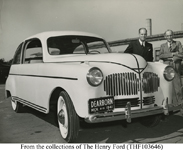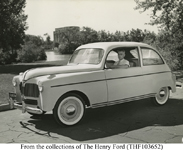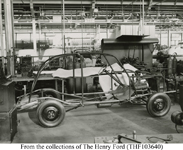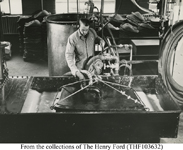Popular Research Topics
Soybean Car
Many people ask us about Henry Ford's experiments with making plastic parts for automobiles in the early 1940s. These experiments resulted in what was described as a "plastic car made from soybeans". Although this automobile never made it into the museum's collections, we thought we would address the myriad questions we receive about this unique and fascinating vehicle.
What is it?
The "Soybean Car" was actually a plastic-bodied car unveiled by Henry Ford on August 13, 1941 at Dearborn Days, an annual community festival.
What was it made of?
The frame, made of tubular steel, had 14 plastic panels attached to it. The car weighed 2000 lbs., 1000 lbs. lighter than a steel car. The exact ingredients of the plastic panels are unknown because no record of the formula exists today. One article claims that they were made from a chemical formula that, among many other ingredients, included soybeans, wheat, hemp, flax and ramie; while the man who was instrumental in creating the car, Lowell E. Overly, claims it was "…soybean fiber in a phenolic resin with formaldehyde used in the impregnation" (Davis, 51).
Who helped make/design it?
Henry Ford first put E.T. (Bob) Gregorie of the Styling Department in charge, but was not satisfied. He then transferred the project to the Soybean Laboratory in Greenfield Village and to the care of Lowell E. Overly, whose formal training was in tool and die design. His supervisor, Robert A. Boyer, a chemist, aided him.
What was it used for?
The car was exhibited at Dearborn Days in 1941. It was also trucked to the Michigan State Fair Grounds for display later that year.
Why was it built?
There were several reasons why Henry Ford wanted to build this car: 1.) He was looking for a project that would combine the fruits of industry with agriculture. 2.) He also claimed that the plastic panels made the car safer than traditional steel cars; and that the car could even roll over without being crushed. 3.) Another reason was due to a shortage of metal at the time. Henry hoped his new plastic material might replace the traditional metals used in cars.
Why weren't more 'soybean' cars built?
The outbreak of World War II suspended all auto production, and therefore the plastic car experiment. A second unit was in production at the time the war broke out, but the project was abandoned. By the end of the war the idea of a plastic car had fallen through the cracks due to energy being directed towards war recovery efforts.
Where is the car today?
According to Overly, the car was destroyed by E.T. Gregorie. (Davis, 51).
Note
The famous picture of Henry Ford hitting a car with an ax is not a picture of the soybean car. It was actually Ford's personal car with a plastic rear deck lid made to fit it. He liked to demonstrate the strength of the plastic, and the ax he used would fly out of his hands, about 15 ft. (a rubber boot was placed on the sharp end of the ax) into the air.
Images
(click for larger view)





Images: Details From 1) THF103646; 2) THF103652; 3) THF103640; 4) THF103632; 5) THF103654
Soybean Car Source Notes:
(All sources available in the Benson Ford Research Center Collections)
Bryan, Ford R. Beyond the Model T. Detroit: Wayne State University Press, 1997, 112-113.
Davis, Rusty. "Henry's Plastic Car: An Interview with Mr. Lowell E. Overly." V8 Times[?], 46-51.
"Ford Builds a Plastic Auto Body." Modern Plastics. September, 1941.
Lewis, David L., The Public Image of Henry Ford. Detroit: Wayne State University Press, 1976, 283-285.
McCann-Erickson, Inc., Penobscot Building Detroit, MI. "Ford Completes First Plastic Body as Steel Goes on Priority List." August 14, 1941.
Wik, Reynold M. Henry Ford and Grass Roots America. Ann Arbor, MI: The University of Michigan Press, 1972, 151-152.